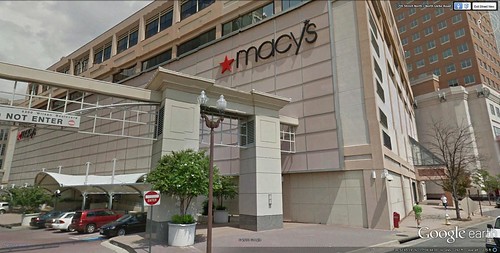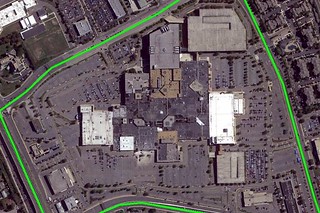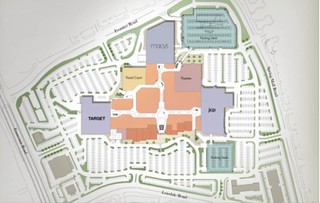Welcome the age of the 'anti-mall' (maybe?)

Posted August 26, 2013 at 1:23PM

Anti-malls are the new malls. So proclaims the staff of DC area booster magazine Washingtonian, in a fun compendium of “The Best of Washington: 62 Reasons to Love Our City” (July 2013). Even the suburbs are figuring out that walkable retail, not enclosed malls surrounded by parking lots, is the way to go in the twenty-first century:
“With sophisticated shopping centers such as the Mosaic district in Merrifield and Bethesda Row, suburbs are taking a cue from their urban brethren by shifting to walkable, tree-lined town centers—combining community, thoughtful design, and carefully curated boutiques (Ginger, Bellacara) with specialty eateries. A far cry from the '80s supermall, these feel completely fresh—thanks in no small part to the open air.”
I was especially pleased to see the mention of Bethesda Row, the best example of successful suburban retrofit that I know. Indeed, my co-authors and I were so impressed by the then work-in-progress that we chose it for the cover of our 2001 book, Solving Sprawl. Bethesda, a once-sleepy if upscale inner suburb in nearby Maryland, was almost totally automobile-dependent in 1994 when the mixed-use, multi-block development was conceived for a decaying commercial/industrial strip; now, in no small part because of developments like Bethesda Row, Bethesda feels both urban and urbane, yet still human-scaled. It’s a great place to be.
Rachel Nania, writing for the local all-news radio station WTOP, agrees that the landscape of area retail is changing dramatically, with enclosed shopping malls on the decline. She cites the Ballston Common Mall in another DC inner suburb, as an example. It sits almost on top of a Metro station but is losing customers.
Nania interviewed me for her article, and I speculated that one reason might be that Ballston Common was built on a decidedly suburban model, yet soon after it opened the surrounding area underwent massive redevelopment, making it one of the most urban places in the DC suburbs. The mall became out of place in the new environment, auto-oriented, most of its stores invisible from the street, greeting the pedestrian with blank walls in many places (see photo of the Macy’s at Ballston Common). It’s outdated for its now-urban location.
(I also think it may not help that the surrounding neighborhood of Ballston, although part of one of the country’s most successful transit corridor makeovers, is – at least to my eyes – a collection of big-box buildings with mediocre architecture and a lack of soul. The contrast with the sophisticated and appealing design of Bethesda Row is striking. Unlike the case with Bethesda Row, few people are likely to see Ballston as a destination neighborhood, a place to visit even if one is not already there.)
The decline of malls is also influenced by macroeconomic forces, as I alluded in my recent article on dying malls. Nania interviewed a number of experts on the retail economy and among their observations were these:
- The stock market crash of 2008 dampened consumer spending.
- Around the same time, many retailers over-expended their chains, in effect causing “them to go from ‘exclusive’ to ‘a commodity.’”
- The millennial generation is less interested in “stuff” and more interested in “experiences.”
- “18 percent of shopping today is done online. Before 2008, “5 percent of sales could be attributed to online shopping.”
The effect is that retail in general “is going to be smaller in the future, not larger,” according to Bruce Leonard, a development analyst who spoke with Nania.
The bright side, though, is that more walkable, lifestyle-oriented retail can be quite successful in the new century, if well planned. Nania cites local example Springfield Town Center, the redevelopment of the old Springfield Mall in suburban Virginia. David Versel of George Mason University, who spoke with Nania, reports that the new Town Center is “going to be a much different place than it was. It's going to have less space. It's going to be more oriented towards the outdoors and less oriented towards the air conditioned, controlled space inside the mall.” In other words, it may be going in the direction of walkability.
But is it, really? Will the new Springfield development be the kind of “anti-mall” that Washingtonian heralds as the best of new-generation shopping? I have serious doubts. Compare the satellite photo of the old mall with the rendering of the new concept. The new Springfield Town Center may have more outdoor spaces, but it will still be surrounded by surface parking (enough for 7600 cars, apparently) and everything about the promotional video I just watched for the new development screams “same old mall experience with a few new bells and whistles” to me.
There’s some, but not much, housing or even office space within convenient and safe walking distance. Almost everyone will arrive by car, the promotional video assumes. My guess is that novelty may give the new “town center” a few good years but that’s about it. It’s a shame, because there was an opportunity there to build a truly walkable, mixed-use development with housing and office space along with a revamped shopping experience, with at least some integration with the nearby community.
The effect will be counter to emerging preferences, which Nania’s article summarizes this way:
“The millennial generation is increasingly spending its income in the food, beverage and entertainment sectors. Neighborhood-based developments and revitalization projects at Union Market, Bethesda Row, H Street and Barracks Row are products of this trend in the D.C. area.
“Now, development companies are looking more along the lines of creating spaces adaptable to ‘experiences,’ such as condos or apartments with retail and food on the ground floor.”
That, in my opinion, is the wave of the future, and the developers, retailers, and communities that respond best to the new preferences will be the most successful as the twenty-first century continues to evolve.
Related posts:
- Malls and big boxes continue to lose their grip - will this mean more abandoned properties? (July 24, 2013)
- As we remake suburbs, should we guard against "commercial gentrification"? (June 11, 2013)
- How to retrofit failing suburban big-box stores into a green showcase (March 12, 2012)
- Can this dead suburban mall be transformed into something better? It's complicated. (June 13, 2011)
- The big-box ghosts of shopping past (December 18, 2009)
Move your cursor over the images for credit information.


